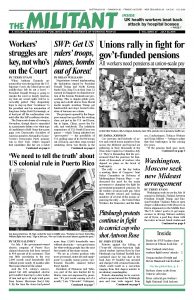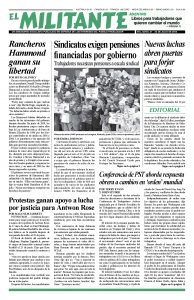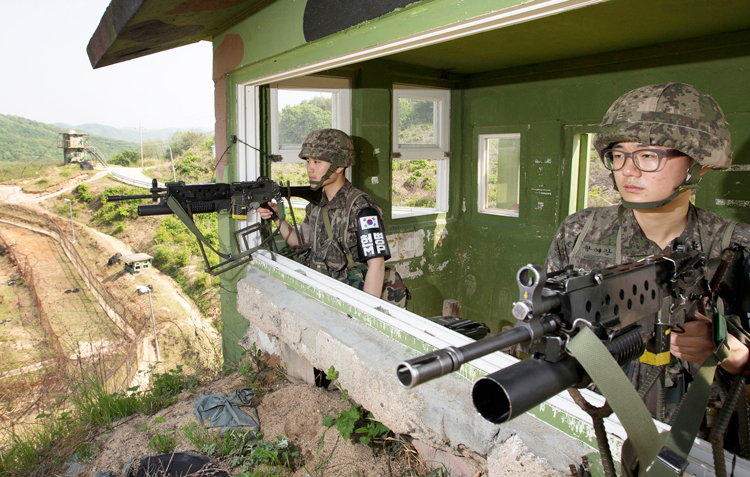Negotiations toward implementing the declaration signed by President Donald Trump and North Korean leader Kim Jong Un at their June 12 summit in Singapore on denuclearization of the Korean Peninsula are proceeding. This is despite public jockeying and a shrill chorus from liberal media moguls insisting Trump got bamboozled and steps toward relaxation of tensions are a sham.
The prospects opened by the Singapore summit are good for the working class, not just in the U.S. and Korea, but in Japan, China, across the Pacific and worldwide. The indefinite suspensions of U.S.-South Korea war games — which Trump admitted are “provocative” — the possibility of U.S. pulling some of its 28,500 troops out of Korea, and other steps toward ratcheting down war threats in the region are welcome. These steps and more from Washington and reciprocal moves toward denuclearization in Korea can lead toward elimination of barriers to travel and communication, and for economic and political relations in the region that would be a historic advance.
Secretary of State Mike Pompeo visited Pyongyang July 6-7 for talks with Kim Yong Chol, vice chairman of the Central Committee of the Workers’ Party of Korea. Pompeo told the media the talks were “very productive,” and that some progress was made “on almost all the central issues.”
Representatives of the Pentagon and the Democratic People’s Republic of Korea will meet again around July 12 in Panmunjom, in the “demilitarized zone” separating the two Koreas, to discuss returning remains of U.S. soldiers from the 1950-53 Korean War, something the North Korean government has agreed to do. The two governments also agreed to set up working groups, overseen by Sung Kim, the U.S. ambassador to the Philippines, to prepare future meetings. Pyongyang also confirmed, Pompeo said, plans for destroying a testing facility for intercontinental ballistic missiles. In May the North Korean government destroyed the tunnels at its Punggye-ri nuclear testing site.
Pompeo asserted that the sanctions imposed by the U.N. and U.S. over the past decade will remain in place and be pursued “with vigor” until the U.S. rulers are fully satisfied that denuclearization in the North is well underway. These sanctions, imposed under Democratic and Republican administrations alike, have increasingly tightened the squeeze on working people there.
Hours after Pompeo left Pyongyang, a North Korean Foreign Ministry spokesman issued a statement describing the secretary of state’s visit as “regrettable.” The unnamed official’s key complaint was that “the U.S. side came up only with its unilateral and gangster-like demand for denuclearization,” without offering significant steps to aid and defend North Korea itself.
The heart of the back-and-forth, whatever the verbiage, is jockeying for who will give up what as a series of concessions are pursued.
The liberal pundits, who view all politics through their anti-Trump hysteria, grabbed onto the statements to step up allegations that Trump had been conned and North Korea is instead upgrading its nuclear threat.
“I have confidence that Kim Jong Un will honor the contract we signed,” Trump said in a tweet July 9. “We agreed to denuclearization of North Korea.”
Trump added that one factor influencing the pace of the talks is the ongoing trade dispute between Washington and Beijing. Beijing “may be exerting negative pressure on a deal because of our posture on Chinese Trade — Hope Not!” he said.
U.S. rulers’ bloody war on Korea
Another key issue in dispute is Washington’s refusal to sign a permanent peace treaty with Pyongyang formally ending the 1950-53 Korean War. The South Korean government says it is eager to sign on. The history of Washington’s aggression in Korea gives people there good reason to be concerned about the U.S. rulers’ intentions.
In 1945, Washington joined with the Stalinist rulers in Moscow to partition Korea and U.S. troops poured into the South. Washington proceeded to crush revolutionary mobilizations there, while workers and farmers in the North ousted capitalist rule and took power. After the Korean War broke out in 1950, the U.S. rulers used massive bombing and napalm to level virtually every building in North Korea. More than 4 million people were killed, half of them civilians. President Harry Truman had nuclear weapons transported to the region and threatened to use them.
When U.S. forces marched almost to the border with China, Korean fighters, backed by hundreds of thousands of Chinese volunteers, drove them back, fighting them to a stalemate at the 38th parallel — the first military defeat for U.S. imperialism. In 1953 the U.S. government signed a cease-fire agreement with Pyongyang, but has refused to sign a peace agreement for the past 65 years.
The division of Korea is the only remaining unresolved national separation that emerged out of the second imperialist world war.
A statement issued recently by the Socialist Workers Party points to the importance of the Washington-DPRK talks. “The stakes have never been higher in ensuring a nuclear-free Korean Peninsula and Japan,” the statement says, “including an end to Washington’s nuclear ‘umbrella’ and deployment of nuclear-armed warships and submarines in the surrounding seas and skies.
“Korea is one!”


